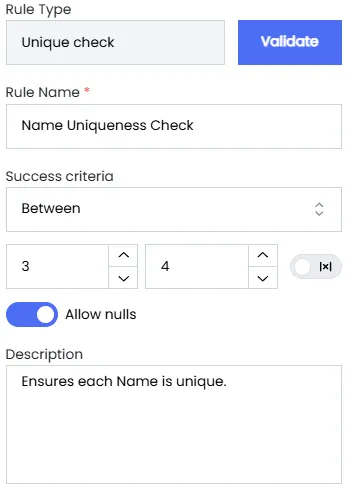Unique Check
Description
The Unique Check rule is a validation or constraint used to ensure that values within a dataset are unique. This check verifies that no duplicates exist for a specific field or column that is supposed to contain unique values.
Configuration Fields
-
Operator Options
Greater thanLess thanEqual toBetween(requires specifying a start and end range)
-
Operator Defines the comparison operation (Greater Than, Less Than, Equal To, or Between).
-
Value The threshold value used for success criteria. Required for
Greater than,Less than, andEqual tooperators. -
Value Range Required only when the
Betweenoperator is selected, specifying thestartandendrange. -
Threshold Type Indicates whether the
ValueorValue Rangeto be considered as percentage or an absolute count. -
Allow Null Values Determines if null values are permitted.
Success Criteria
The success criteria for a Unique Check rule typically determine whether the data set meets the requirement for uniqueness. If the data passes the check, it implies that the uniqueness constraints are satisfied and there are no duplicate values where they shouldn’t exist.
- Ensure no duplicate entries in the specified field or column.
- The success condition is met if this count satisfies the given
operatorandvalue. - For example “Alice” should be unique, meaning no two names in the database can have the same “Alice” value.
Sample Input
| ID | Name | Value |
|---|---|---|
| 1 | Alice | 12345 |
| 2 | Alice | 67890 |
| 3 | Jake | 12345 |
| 4 | Brian | 12345 |
| 5 | Daisy | Null |
Sample Success Criteria Configuration
- Operator Between
- Value Range
Start= 3,End= 4 - Threshold Type Absolute Count
- Allow Null Values True

Sample Output
| Column Name | Rule Name | Success Count | Failure Count | Within Threshold |
|---|---|---|---|---|
| Name | Name Uniqueness Check | 4 | 1 | Yes |
| Value | Value Uniqueness Check | 2 | 2 | No |